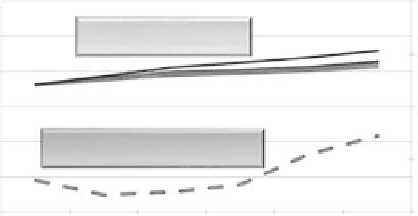Environmental Engineering Reference
In-Depth Information
Public
supply
13%
Mining
1%
Domestic
1%
ermo-
electric
41%
Irrigation
37%
Industrial
5%
Livestock
3%
FIGURE 28.3
Water withdrawals in the United States as estimated in a 2005 report by the US DOE. Note that thermoelec-
tric power generation, mining, and industrial use account for nearly 47% of total withdrawals. (From NETL,
Department of Energy/National Energy Technology Laboratory's Water-Energy Interface Research Program: December
2010 Update
, J.P. Ciferno, R.K. Munson, and J.T. Murphy, eds. National Energy Technology Laboratory, 2010.)
water drawn. Since water use for thermoelectric power generation is a major contributor to
the energy-water nexus, a brief overview of water use, both present and projected, follows.
Recently, the USDOE has projected that thermoelectric generating capacity will increase
by approximately 6% by 2035, based on the data discussed in the US Energy Information
Administration's (USEIA) 2010 annual energy outlook as shown in Figure 28.4 [11,12].
Furthermore, it is estimated that water withdrawal to support electricity generation is
expected to stay the same or decline slightly during the same time period. However, water
consumption is expected to increase by anywhere from 14% to 26% on a national basis. The
difference in water withdrawal and consumption for the estimated use should be clari-
ied, as withdrawal (drawing water for use from a source) will likely remain unchanged
because power plants retiring between 2005 and 2030 are older facilities that are more
likely to employ high-withdrawal, once-through cooling. New facilities that will be built
over that time period are likely to employ lower-withdrawal but high-consumption wet
recirculating cooling systems. It should be noted that the projections do not account for
6
900
14% to 26% increase in
water demand by 2035
5
850
4
3
800
6% increase in thermoelectric
demand by 2035
2
750
1
0
700
2010
2015
2020
2025
2030
2035
Year
FIGURE 28.4
Plot showing water consumption in billion gallons per day in contrast to the thermoelectric power generation
capacity as estimated by the US DOE with projections extended to 2035. (From NETL,
Innovations for Existing
Plants: Water Energy Interface
[cited February 18, 2013]; Available at http://www.netl.doe.gov/technologies
/ coalpower /ewr/water/index.html#top, 2010.)















